Replaces
2004 Isuzu Ascender Front 4 Piece Drivetrain Kit TRQ BHA52926
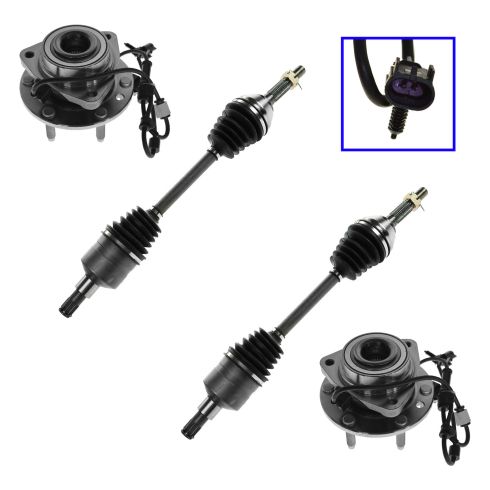



BHA52926
This part doesn’t fit a . Select from parts that fit.
Specify your vehicle's year, make and model to guarantee fit.
Buy in the next and
Get it by: Tuesday, Aug 12 with expedited shipping
You may also like
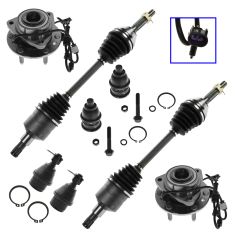
8 Piece Steering, Suspension, & Drivetrain Kit
$349.95
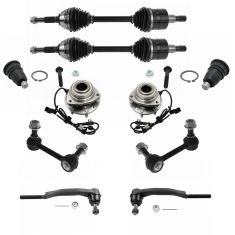
12 Piece Steering, Suspension, & Drivetrain Kit
$354.95
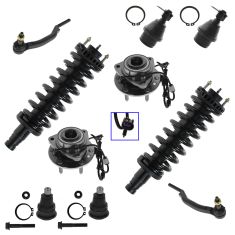
10 Piece Steering, Suspension, & Drivetrain Kit
$359.95
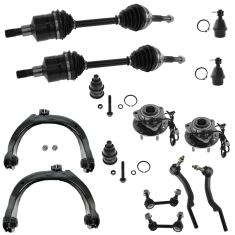
14 Piece Steering, Suspension, & Drivetrain Kit
$374.95
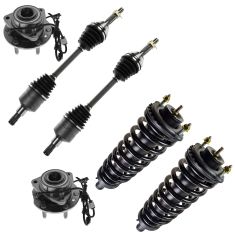
6 Piece Suspension & Drivetrain Kit
$434.95
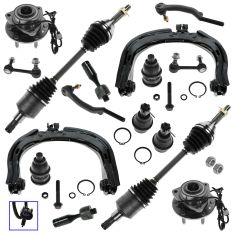
16 Piece Steering, Suspension, & Drivetrain Kit
$479.95
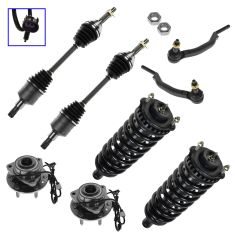
8 Piece Steering & Suspension Kit
$484.95
Part Details
- (2) Front CV Axle Assemblies
- (2) Front Wheel Bearing & Hub Assemblies
- Ball Bearing
- 4 Piece
Specifications
- Front
Product Features
TRQ drivetrain kits are manufactured using premium raw materials to restore original performance. Each TRQ drivetrain component is designed to be a direct, maintenance-free replacement to the stock unit. To extend the service life of your drivetrain, TRQ recommends replacing wheel hubs, bearings, and constant velocity (CV) drive axles at the same time to ensure even wear of components and improved ride comfort. All products are fit and road-tested in our Massachusetts R&D facility to ensure we deliver on our promise of Trusted Reliable Quality.
CV axles are designed to transmit the power from your vehicle's drivetrain to the wheels while being able to flex and pivot to the demands of the steering and suspension systems. If your vehicle is making clicking noises at lower speeds or when making turns, it may be time to replace your CV axles with our 100% brand new assemblies.
Our steering and suspension components are pre-greased and sealed for long life and do not require the extra maintenance typically required by greaseable versions.
Attention California Customers:
![]() WARNING: This product can expose you to chemicals including Lead and Lead Compounds, which are known to the State of California to cause cancer, and birth defects or other reproductive harm. For more information, go to www.P65Warnings.ca.gov.
WARNING: This product can expose you to chemicals including Lead and Lead Compounds, which are known to the State of California to cause cancer, and birth defects or other reproductive harm. For more information, go to www.P65Warnings.ca.gov.
Lifetime Warranty
This item is backed by our limited lifetime warranty. In the event that this item should fail due to manufacturing defects during intended use, we will replace the part free of charge. This warranty covers the cost of the part only.
FREE Shipping is standard on orders shipped to the lower 48 States (Contiguous United States). Standard shipping charges apply to Hawaii and Alaska.
Shipping is not available to a P.O. Box, APO/FPO/DPO addresses, US Territories, or Canada for this item.
Expedited is available on checkout to the United States, excluding Alaska, Hawaii.
Final shipping costs are available at checkout.




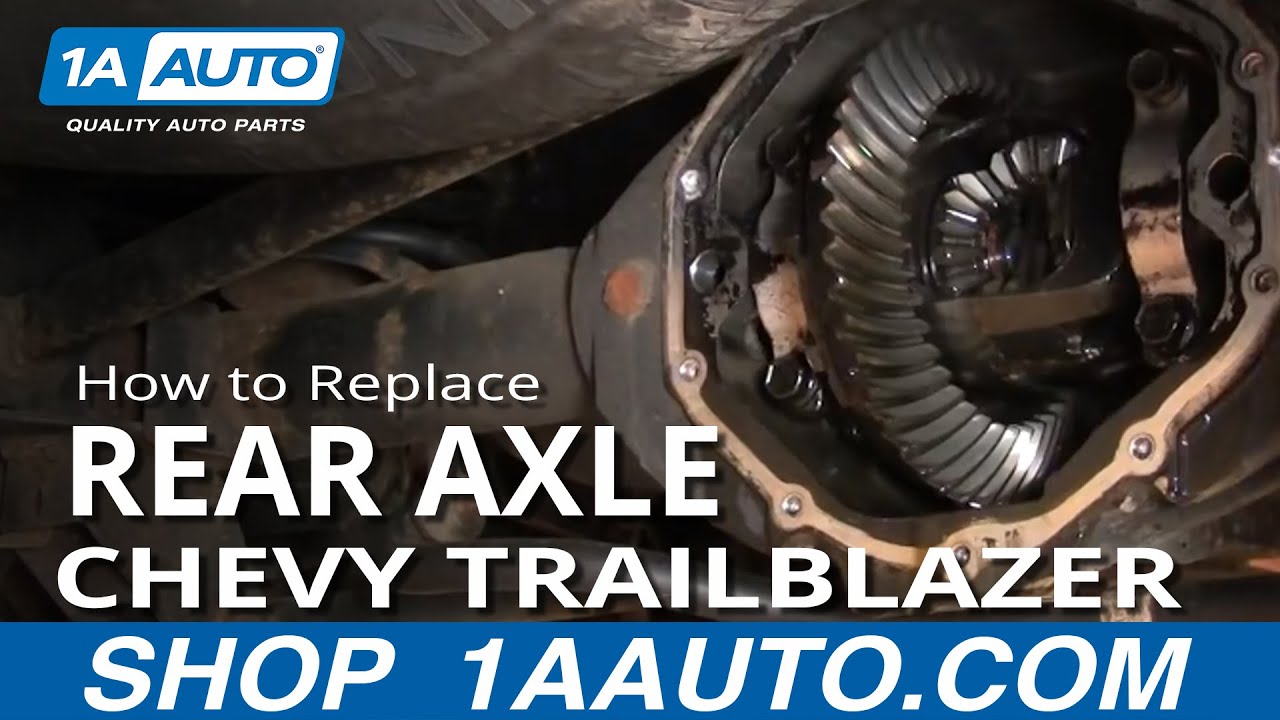
Created on:
Tools used
- Pry off the center cap with a flat blade screwdriver Loosen the lug nuts with the vehicle on the ground Raise the vehicle with a floor jack Secure the vehicle on jack stands Remove the lug nuts Pull off the wheel
- Pry the brake pads in with a flat blade screwdriver to push in the pistons Remove the two 14mm bolts from the brake caliper Pull the caliper aside Pry out the brake pads with a flat blade screwdriver
- Remove two 18mm bolts from the brake caliper bracket Pull off the brake caliper bracket Pull the rotor off If the rotor will not pull off thread two M10 by 7cm bolts into the threaded holes For more detailed instructions, please see the 2004 Trailblazer rear brake replacement video
- Have a drain pan ready Remove all but two bolts from the differential cover Drain the differential fluid
- Put the vehicle into neutral Turn the driveshaft by hand until you can access the differential bolt Remove the 5/16 inch bolt from the differential Pull the clip from the differential Slide out the differential pin Push the axle inward by hand Pull out the small C-clamp from the differential Pull the axle out by hand
- Slide the axle in being sure not to drag against the seal Install the C-clamp onto the axle with the grooved side toward the center Push the axle out by hand Line the gears up by hand Insert the differential pin Start the 5/16 inch bolt into the differential Apply thread locking fluid to the 5/16 inch bolt Tighten the 5/16 inch bolt to between 8 -10 foot-pounds of torque
- Clean the mounting area with a cloth rag Clean the differential cover with a cloth rag Apply sealant to the gasket cover Put the gasket and differential cover into place Start two bolts into the differential cover by hand Start the remaining bolts Tighten the bolts to about 12 foot-pounds
- Remove the differential plug with a 3/8 inch drive ratchet Fill the differential with 80w-90 gear oil, until fluid begins to leak out Put the plug back in and tighten it Clean grease off the rear end
- Slide the rotor on Put the bracket back into place Start the 18mm bolts by hand Tighten the bolts
- Install the new brake pads into the bracket with the wear indicator on the lower side Put the caliper on Thread the two 14mm bolts by hand Tighten the 14mm bolts
- Slide the wheel into place Start the lug nuts by hand Tighten the lug nuts preliminarily Lower the vehicle to the ground Tighten the lug nuts to between 100 - 120 foot-pounds in a crossing or star pattern Reattach the center cap
- Pump your brakes repeatedly until they feel firm Test your brakes at 5 miles per hour and then 10 miles per hour Road test the vehicle
Brought to you by 1AAuto.com, your source for quality replacement parts and the best service on the Internet.
Hi, I'm Mike Green. I'm one of the owners of 1A Auto. I want to help you save time and money repairing or maintaining your vehicle. I'm going to use my 20-plus years experience restoring and repairing cars and trucks like this to show you the correct way to install parts from 1AAuto.com. The right parts installed correctly: that's going to save you time and money. Thank you and enjoy the video.
In this video, we're going to show you how to remove a rear axle on this 2004 Chevy Trailblazer. This is pretty indicative of any Chevy or GM product that has a C-Clip rear axle, and when I say C-Clip, you'll see what I mean in the video. You'll need various metric and standard sockets or wrenches, ranging in size from 5/16's inch to 19 millimeters with the ratchets and the extensions, a breaker bar or a pipe for leverage for some of those bolts that are tighter than others, catch pin, jack and jack stands, flat blade screwdriver and two M10 by 7 centimeter bolts, as well as a 3/8's drive ratchet with an extension.
For the rear tire, the lug nuts are 19 millimeters. If you don't have air tools, you want to start with the vehicle on the ground, loosen the lug nuts, raise it, support it with jack stands, and then remove the lug nuts. We'll use some fast forward as we remove the rest of the lug nuts and the wheel.
We want to use a screwdriver. What I'm doing is pulling out on the caliper. That just helps to get it off the brake pads. You remove two bolts, and then remove the caliper. On this vehicle, those are 14 millimeter bolts. Pull up on the caliper, put it up and out of your way, and then you can just pry out the brake pads. You actually can skip this step. You can just pull the bracket off. Then you want the pad bracket, two 18 millimeter bolts on this vehicle. I'm going to use a piece of pipe, along with my ratchet, and the pipe actually just gives you some extra leverage. Then on the lower bolt on this vehicle, it has a clearance issue, so I'm going to put on my 18 millimeter wrench. Then I'm going to hook another 17 millimeter wrench on to it and pull down. Then, finish off taking those bolts out. Now, the bracket comes off, and then hopefully, your disc will just pull off. On this vehicle, it doesn't, but the vehicle has two threaded holes, so you insert some M10 metric bolts and use your wrench. You tighten those bolts up, which forces the disc off of the hub.
Now, you want to turn your drive shaft with your vehicle in neutral until you have a good angle at that bolt right there. Using a 5/16 inch socket, remove this bolt. As you remove this bolt, you want to hold this pin up here, pull that bolt out, and let that slowly slide down. That will allow you to actually push your axle in, which then allows you to pull out a C-clamp. It should just fall down here. I need a magnet. That C-clamp comes out, which now allows you to pull out slowly your axle.
Now, put the axle back in. You want to lift up on it so it doesn't drag against your seal. You just move it around a little bit, push it in, just has to find its way on the inside. Here, what you're really hoping is nothing has moved, so we're going to take our C-clamp, and the side that has a groove near the center is the one you want to put towards the center. You just put that on to the axle that's pushing out through right there. Then you can actually push the axle back by hand. Make sure you have this shaft nice and clean. Put it up in with the hole at the bottom. This is where you're hoping that these gears didn't move around at all. It would appear that they did just a little bit. I'm just going to line it up with my finger. It goes in, push this in, start it into place, and your axle's locked back in place. As that's going in, I'm just going to hit it with a little dab of Loctite. Being greasy and stuff, it's not going to stick that well, but that's okay. You want to tighten this up probably to about 8 to 10 foot pounds, which is tight with this little wrench. That's good.
Now we're going to get back into cleaning everything up and putting it back together, so I just wipe down the inside as much as I can, get as much dirt and everything out of there as possible. Now clean up and wipe down your rear end cover, and there's a little rectangle there that's the magnet. Make sure you get that wiped off really well. Right there displaying it, you can see I clean it up better. On this one, you do reuse your gasket, and I put just a little bit of sealant on the cover just to help with some of the crustiness from the rust. Now, we'll put our cover up there, start it with a couple bolts, then start all the bolts by hand, and then tighten them preliminarily with a wrench after that. Now, we skip forward. You want to torque these bolts to about 12 foot pounds. It's not very much, but it's enough to seal it. You don't want to over-torque it, because you'll get leaks because you warp your differential cover. About 12 foot pounds, I tighten them using an opposite pattern, and then I just go around one by one and just make sure they're all tight.
Now, we're going to refill the rear end. There's a plug right on the passenger side. Use a 3/8's ratchet with an extension, remove that plug, and then fill it with 80w-90 gear oil. I use a little tube; it helps get the bottle in the position so that you can fill it easier. Once you've filled it and the fluid starts dripping down, put your plug back in, tighten it up. You don't have to tighten it incredibly tight, but get it nice and snug, and then wipe down all the grease off of the rear end so you can check for leaks later.
Now, I'm going to put the brakes back together. If you want to see this in regular speed, just check out our other videos for the Trailblazer rear brake installation. You can see I've got both a new backing plate and new brakes on there. If you want to see those, just check out our other videos on the whole process for that. We'll get through that.
Very important, you've had your brakes apart, you obviously want to torque your lug nuts on there properly. You want to pump your brakes afterwards, make sure that you get your brakes reset and make sure that they're working properly before you test drive the vehicle. Torque the lug nuts to between 100 and 120 foot-pounds. I use a crossing star type pattern, and then you can put your cap back on. Always make sure after you've had your brakes apart, that you pump the pedal a bunch of times, work the pressure back up, and make sure you work the brake caliper pistons back into place.
We hope this video helps you out. Brought to you by www.1AAuto.com, your source for quality replacement parts and the best service on the Internet. Please feel free to call us toll-free, 888-844-3393. We're the company that's here for you on the Internet and in person.
Tools used
- Pry off the hub cap with a flat blade screwdriver Loosen the 35mm hub nut with the vehicle on the ground Loosen the lug nuts in a crossing or star pattern Raise the vehicle with a floor jack Secure the vehicle on jack stands Remove the lug nuts Pull off the wheel
- Remove the 17mm bolts from the brake caliper while using an 18mm wrench to hold the inside nut Pry the brake pads into the caliper with a flat blade screwdriver to push in the pistons Pull the caliper aside Pry the brake pads off with a flat blade screwdriver Remove the 18mm bolts from the brake caliper bracket Pull off the brake caliper bracket Pull the rotor off If the rotor will not come off hit the rotor with a ball peen hammer If the rotor still won't come off, thread the bolts into the press holes and slide the rotor off Remove the center hub nut Hit the Axle with a hammer
- Disconnect the clips on the harness on the upper control arm Disconnect the wiring harness Spray each side of the hub with penetrating oil Remove the three 18mm bolts holding the hub Hammer the back of the hub to loosen it Pull the harness through and remove the hub Hammer the backing plate off the hub
- Feed the harness through the backing plate Place the backing plate into place Push the hub onto the axle and into place Place an 18mm bolt to hold the plate and hub to the wheel knuckle Replace and tighten the 18mm bolts Torque the 18mm bolt to 90 ft/lbs Clip the wiring harness to the steering wheel knuckle Connect the wiring harness
- Slide the rotor on Thread on one lug nut to hold the rotor in place Apply brake grease to the caliper bracket bolts Put the bracket back into place Start the 18mm bolts by hand and tighten them Torque the bolts to 110 ft/lbs of torque Install the new brake pads into the bracket Apply brake grease to the brake pads Put the caliper on Thread the 17mm bolts by hand Torque bolts to 40 ft/lbs Replace the hub nut and remove the lug nut
- Slide the wheel into place Start the lug nuts by hand Tighten the lug nuts preliminarily Lower the vehicle to the ground Tighten the hub nut Torque the lug nuts to 100 ft/lbs in a crossing or star pattern Torque the hub nut to 103 ft/lbs Reattach the center cap
- Pump your brakes repeatedly until they feel firm Test your brakes at 5 miles per hour and then 10 miles per hour Road test the vehicle
Brought to you by 1AAuto.com, your source for quality replacement parts and the best service on the Internet.
Hi, I'm Mike from 1A Auto. I hope this how-to video helps you out, and next time you need parts for your vehicle, think of 1AAuto.com. Thanks.
In this video, we're going to show you how to replace a front hub on this 2003 GMC Envoy XL. The items that you'll need for this is a new hub from 1AAuto.com, a 17mm, 18mm, 19mm and 35mm socket and ratchet, a piece of pipe for extra leverage, 18mm wrench, flat blade screwdriver, torque wrench, hammer, and jack and jack stands.
Start off by prying off your hub cap. Then just loosen up this 35mm nut. Now loosen the lug nuts in a crossing pattern. We'll just fast-forward as Mike does this. Once you've loosened them, just jack the vehicle up, and then remove the lug nuts the rest of the way. Now the wheel will pull off.
Now, you want to remove these two 17mm bolts, and you can see Mike's using an 18mm wrench to hold the nut on the inside. That'll just make it easier to remove that bolt. Now, using a flat blade screwdriver, just pry out on the caliper. Then you can just set that aside.
Now pry out your brake pads. Now, you want to remove these two 18mm bolts. We'll just fast-forward as Mike does that, and you can see he's using a piece of pipe for some extra leverage to help break those bolts free. Remove the bolts the rest of the way, and then the caliper bracket comes off. Now, you need to remove your rotor, and hopefully you can just use a hammer, tap on the rotor a little bit, and it will come off. Our vehicle has some corrosion, so we end up using the alternate method.
If you have trouble getting the rotor off, it actually has press holes. You would get a bolt that's the proper size, I believe this an M12 bolt, and you use two bolts, thread them into those holes, and as you tighten them up, they press against the hub and push the rotor off. Once you've removed the rotor, if you haven't already, remove the center hub nut the rest of the way. Give the axle a good firm hit with a hammer, and once you see it's moving, then you know it's free.
Next, you want to disconnect these clips along this harness. To do that, you just flip those open with a flat blade screwdriver, or you can just pry them out. First, pull the harness connection out from the car, and then push the tab and disconnect the harness. We'll just fast-forward as Mike pries out those clips. Just note, that we did just unclip the harness that is connected to the upper control arm and left it in place. Now, just remove these three 18mm bolts that hold in the hub.
First, we're just going to spray the other side with some penetrating oil to help remove them. We'll fast-forward as Mike removes these. It does help to turn the wheels so you have better access to whichever one you're working on at whatever time. Now, using a hammer, just hit the back of the hub to loosen it, and then just slide it off the axle, making sure your harness is pulled through. Then just hammer that backing plate off the hub and pull your harness up and out of the plate.
On the left is the old hub; on the right is the new one from 1A Auto. You can see they're identical, and they'll fit exactly the same. Take your backing plate and feed the harness of your new hub through it. Then put the backing plate into place on the wheel knuckle. You want to make sure that the harness is going up through that top part of the plate. Once you have that lined up, push the hub back onto the axle and into place.
Once it's in place take a bolt and just twist in to hold the plate and hub to the wheel knuckle. Then just replace the other two bolts, and tighten all three of them up. Now, torque each of these to 90 foot-pounds. We left some clips in the body of the car, so you just remove the ones you don't need from your new harness, and the ones you do need just leave on there and push into place on the wheel knuckle. We'll just fast-forward as Mike re-clips the harness all the way along.
Then reconnect the harness. You want to make sure these holes line up in between the two holes that are on the hub, and then you just slide your rotor back into place, and replace a lug nut to hold it into place. You want to check these slides on your caliper bracket, and make sure they're greased up. If they're not, just apply some brake grease to them. Then fit the bracket into place and then just start twisting your bolts by hand and then tighten them up. Torque each of these to 110 foot-pounds. Then just replace your brake pads, and if there's no grease on the ends, just apply some brake grease.
Now, push your caliper back down into place and replace those two 17mm bolts. We'll fast-forward as Mike does that and tightens those up. Now torque each of those to 40 foot-pounds. Replace the hub nut. Remove the lug nut that you put on there to hold the rotor in place.
Put your wheel in place. Then replace each of the lug nuts and tighten them preliminarily. If you're working with air tools, you can tighten up the center nut preliminarily or you can wait and do this on the ground. Now torque each of these to 100 foot-pounds in a crossing pattern. Then torque the hub nut to 103 foot pounds. Then replace your hub cap.
After you've done any work on the brakes, you want to just pump the brake pedal until it firms up. Then you want to do a stopping test from five miles per hour and then 10 miles per hour.
We hope this video helps you out. Brought to you by www.1AAuto.com, your source for quality replacement parts and the best service on the Internet. Please feel free to call us toll-free, 888-844-3393. We're the company that's here for you on the Internet and in person.
Tools used
- Raise and secure the vehicle. Remove the lug nuts and then the wheel.
- Turn wheels all the way in the opposite direction of the side you are working on. Use your 13mm socket wrench to remove the caliper bolts. Use a wire tie to help prevent stress on the caliper. Use your 18mm socket to remove the brackets.
- Take care not to touch the disk, and if you do make sure to clean it with rubbing alcohol or mineral spirits.
- Use a 35mm socket to remove the hub nut. Give the axle a slight tap with a hammer to loosen it. Remove the 3 bolts securing the hub using your 18mm socket and extension and ratchet or breaker bar. You can use penetrating oil to help. Disconnect your ABS sensor. Use a rubber mallet to break your hub free, and work around the flange with the hammer to pull it off. Remove the hub and shield. Clean up any corrosion with a wire brush.
- Use some penetrating oil to prep the knuckle for the new hub. Put the three 18 mm bolts in place and tighten the nuts to 90 ft lbs. Reinstall the ABS harness. Tighten but don't torque the lug nut.
- Remember to replace the lug nuts on in a star pattern. Lug nuts tighten to 100-120 ft lbs Hub nut is 103 ft lbs. Make sure to check your brakes and steering before driving again. Make sure to pump the brakes and seat your rotors.
Brought to you by 1AAuto.com-- your source for quality replacement parts and the best service on the internet.
Hi, I'm Mike Green. I'm one of the owners of 1A Auto. I want to help you save time and money repairing and maintaining your vehicle. I'm going to use my 20 plus years' experience restoring and repairing cars and trucks like this to show you the correct way to install parts from 1AAuto.com. The right parts installed correctly, that's going to save you time and money. Thank you and enjoy the video.
In this video, we're going to show you how to remove and replace the front wheel bearing hub on this 2004 Trailblazer. This is the same for many 02' to 09' Trailblazer, Envoy, Bravada, Rainier, Saab 9-7X, as well as Isuzu Ascenders. Tools you'll need are various millimeter sockets, a breaker bar or pipe, if you need some extra leverage. I actually didn't need the extra leverage on this vehicle, but I do show you how to use it, flat blade screwdriver, wire brush, a large c-clamp to reset the pistons in the caliper, torque wrench, 35-millimeter socket, which is something that most toolboxes don't have, but you do need that 35-millimeter socket and then jack and jack stands.
Start by prying your cap off. That's a 19 millimeter and if you don't have air tools, you want to start with the wheel on the ground, loosen the lug nut, then raise it, port it with jack stands and then remove the wheel and the tire. I'll just fast forward taking off the rest of those lug nuts and then removing the wheel and tire.
Now either pull or using the steering wheel, turn your wheels, so you have easy access to the back of the brake calipers. Now, we're going to check the condition of the brakes. Now, I spin this, you'll the rotor move. Okay. Then right to the right there, there's actually your pad. As you can see, there's not that much life left and it's not looking well on the outside either. We're going to remove the caliper, which is removing a bolt up here and a bolt down here and then after that, we're going to remove the caliper bracket, which is two large bolts, 18 millimeter one here and one up here.
The bolts on the caliper, relatively easy, 13 millimeter, use a small wrench. We'll just speed it up here as I remove those two bolts. Okay, the caliper comes right off. You can put that over here. Okay. These are 18-millimeter bolts for the caliper bracket. You're going to want a breaker bar, which is a bar to give you extra leverage. Okay. As you can see, it actually come apart pretty easy. If you don't have a breaker bar like this, you just have a ratchet, you can put a piece of pipe on to give you extra leverage and pull it easy on the pipe and it should have come loose.
When you're all the way up, you can just take your pads off. Take your screwdriver, which should pretty easily pry out. All right. You can see this one. That little line down the middle is the wear and tear. It's actually just about at the end of its life.
We'll fast forward again as we remove those two 18-millimeter bolts that hold that caliper bracket. Okay, that comes off. Then your discs should just come off. If your discs don't come off, there are threaded holes and you need to use some bolts. What you do is you put the bolts in there and the bolts crack against the hub to push them out. Okay. These rotors are pretty crusty looking so I am going to replace them using a 35-millimeter socket. If you don't have an impact wrench, what you'll need to do is, you'll do this at the beginning, you pull that cap off your wheel and then with the big breaker bar and a pipe, you'll loosen this hub nut. Because I have an impact wrench, I can do it this way.
When you're replacing the hub, you don't want to go just hammering away on the axle because you can damage your CV joint, but most of the time, if you just give this one good whack, you'll see that it's broken loose. Basically, just watch the relationship of your axle to your hub when you give it a good hit. Okay and it moved just fine. Just a note, I've yet to have a GM car, where just hitting it with the hammer once didn't break it free.
Right in behind there are three bolts, one here, one up there and then there's one around the back side as well, right down there. Now I get to those bolts. I'm going to take an 18-millimeter socket with a short extension. Okay, put it right on there. I'm going to use the poor man's method. I've got my ratchet and keep the pipe for leverage. Okay. Now I'm going to pull nice and easy and actually these come apart pretty nicely.
Now I'm going to speed up as I loosen the other two and remove those three bolts. Okay, your lead comes out. Okay, follow it around and we'll clip back here, push with the screwdriver, push on the other side, and push that out. Okay, and pry these right out. Now I'm going to really speed through here. All I'm going to do is follow the ABS lead up and pry out the connectors. One note is to check your new hub because that will tell you kind of how the connectors come apart, whether or not you need to pry them out of the frame or just open them up, so that you can put the new lead in.
This last connector with a tab right beside here, go in, lift up, and pull that off here. Okay, turn to the side, that out, off. All three of my bolts are off and my harness is disconnected. Just take a hammer. Okay. It all pops off. You need to get this metal shield off. Okay, get the metal shield off by using a combination of tap it off with a hammer and there's your hub. Take a wire brush here. Just clean off some of the scale. Okay, put that back on and a new hub from 1A Auto, exact same thing as the old one. Take the harness and put it back in place, work it onto the CV, push it on, take one of the bolts, put it through here, move the back end plate and start it into the hub. Grab the other two bolts.
I'm just going to speed it up as I reconnect that harness and route all the clips. It's very important to clip it back into place as it was originally, keeps the ABS harness from rubbing against anything and possibly damaging your ABS brakes.
Now we're going to put the torque on these three bolts to 90-foot pounds. I'll fast forward a little bit as I torque the other two bolts and again, I said I torqued them to 90-foot pounds. We're going to put our hub nut on and we're just going to ... we're not torquing it right now. We're just pulling the CV axle into the hub. Here, I'm going to fast forward through putting the brakes back together. If you'd like to see this in real time, just check out our video for the Trailblazer brakes and do please keep watching because I do go through torquing the center nut on the hub, as well as some other important information about what you need to do after you've had your brakes apart.
With the tire back on the ground, I'm going to torque the lug nuts to between 100 and 120-foot pounds, kind of just using a crossing pattern. Now here, I'm going to tighten that lug nut to 103-foot pounds. Very important after doing brake work, always pump your brakes many times and then before you do a road test, make sure the brakes hold the vehicle in gear and then do a stop from five miles an hour and ten miles per hour before hitting the brakes.
We hope this helps you out. Brought to you by www.1AAuto.com-- your source for quality replacement parts and the best service on the internet.
Please feel free to call us toll free, (888) 844-3393. We're the company that serves you on the internet and in person.
Tools used
- Pry off the hub cap with a flat blade screwdriver Loosen the 35mm hub nut with the vehicle on the ground Loosen the lug nuts Raise the vehicle with a floor jack Secure the vehicle on jack stands Remove the lug nuts Pull off the wheel
- Remove the 17mm bolts from the brake caliper while using an 18mm wrench to hold the inside nut Pry the brake pads into the caliper with a flat blade screwdriver to push in the pistons Pull the caliper aside Pry the brake pads off with a flat blade screwdriver Remove the 18mm bolts from the brake caliper bracket Pull off the brake caliper bracket Pull the rotor off If the rotor will not come off hit the rotor with a ball peen hammer If the rotor still won't come off, thread the bolts into the press holes and slide the rotor off Remove the center hub nut
- Remove the 15mm bolts from the panel to access the driver side Remove the 15mm bolts from the control arm with a socket, ratchet, and wrench Hammer the upper control arm off the ball joint Pry open the clip and remove the brake line wiring harness Wire-tire the caliper onto the backing plate Remove the two 10mm bolts from the brake line bracket Pull the control arm back from the steering knuckle Place a pry bar onto the back of the axle where it connects to the transmission Hammer the pry bar to push the axle out Place a drip pan underneath the differential Maneuver the axle out of the differential
- Fit the axle into the hub and then push it into place As you go, place the steering knuckle into the ball joint on the control arm Make sure the axle is locked Replace the brake line bracket Insert and tighten the 10mm bolts to the brake line bracket Re-clip the harness to the brake line Hammer the upper control arm onto the ball joint Replace and tighten the 15mm bolts to the control arm Torque the 15mm bolt to 55 to 60 ft/lbs
- Slide the rotor on Thread on one lug nut to hold the rotor in place Apply brake grease to the caliper bracket bolts Put the bracket back into place Start the 18mm bolts by hand and tighten them Torque the bolts to 110 ft/lbs of torque Install the new brake pads into the bracket Apply brake grease to the brake pads Put the caliper on Thread the 17mm bolts by hand Torque bolts to 40 ft/lbs Replace the hub nut and remove the lug nut
- Slide the wheel into place Start the lug nuts by hand Tighten the lug nuts preliminarily Lower the vehicle to the ground Tighten the hub nut Torque the lug nuts to 100 ft/lbs in a crossing or star pattern Torque the hub nut to 103 ft/lbs Reattach the center cap
- Pump your brakes repeatedly until they feel firm Test your brakes at 5 miles per hour and then 10 miles per hour Road test the vehicle
Brought to you by 1AAuto.com, your source for quality replacement parts and the best service on the Internet.
Hi, I'm Mike from 1A Auto. I hope this how-to video helps you out, and next time you need parts for your vehicle, think of 1AAuto.com. Thanks.
In this video, we're going to show you how to replace the front CV axle shaft on this 2003 GMC Envoy XL. We show you on the passenger's side, but the driver's side is a similar procedure. The items you'll need for this include a new front axle from 1AAuto.com, 10mm, 15mm, 17mm, 18mm, and 19mm socket and ratchet, a piece of pipe for extra leverage, a 15mm and 18mm wrench, flat blade screwdriver, torque wrench, hammer, jack and jack stands, and a pry bar.
Start off by prying off your hub cap. Then just loosen up this 35mm nut. If you don't have the benefit of air tools, you'll want to take this nut off all the way at this point. Now, you can loosen your lug nuts as well. We'll just fast-forward as Mike does this. Once you've loosened them, just jack the vehicle up and then remove the lug nuts the rest of the way. Now the wheel will pull off.
The next few clips, we remove the brakes. You don't have to do this, but in my opinion it does make it easier to see back in there and get the axle out. There are two 17mm bolts that you remove to remove the caliper, hold the caliper slides with an 18mm wrench, and then pry the caliper up and off. You'll want to secure it somewhere with wire ties so that you don't stress the brake line.
Then you can remove your brake pads. Two 18mm bolts hold the caliper bracket in place. Again, you don't really have to do this, but it just helps to be able to see back in there with the rotor out of the way. Remove the two 18mm bolts using a pipe for some extra leverage, and do this slowly and smoothly so you don't break any knuckles or anything like that. The caliper bracket comes up and off. Then you can remove your caliper either by using a hammer, careful not to damage the rotor at all. If you have to hammer more than just a medium taps, then you'd want to use a couple of M12 bolts. They thread it into the holes in the rotor and help to press the rotor off.
Remove the center hub nut the rest of the way if you haven't already. Using a 15mm socket and ratchet and a 15mm wrench, just remove this bolt. Now, using a hammer, just hit the upper control arm off the ball joint. Now, just pry open this clip and pull the harness free. You want to secure your caliper just somewhere out of the way. We just wire-tie it right here onto the backing plate.
Now, you want to remove these two 10mm bolts. We'll fast-forward as Mike does that. Now, just lift up on the upper control arm and pull this back. Make sure that the axle is loosened from the hub. Okay, to get your axle out, you need to use a pry bar or some other long item. You want to put it up in, and put it on the back of the axle right where it connects to the transmission or the axle I should say. Make sure you're hitting the middle and it comes right out. If you want to do the driver's side, you'll need to remove these four 15mm bolts to pull this panel down in order to access it.
Pull your axle the rest of the way out of the differential. Move stuff around a little bit and then get it going up. I'm just going to angle it up a little bit and get it going up, in, and remove it from the hub. Careful of all your ABS wires and hoses and stuff, eventually it comes out. Up top is the old axle; below it is the new one from 1A Auto. You can see they're identical, and they'll fit exactly the same.
Move the new axle up and in. Again, be careful of all your wires. I just feed it right into the hub. Pull it, move, just maneuver a little bit, and get all the way into your hub. Then pull on it and feed it into the axle. Careful with the seal. You want to put the steering knuckle back up in place as you go so you don't over extend the CB. I'm just going to put that in place, push your axle right in, and make sure it's locked.
Now replace your brake line bracket and the 10mm bolts that hold it into place. You just want to use the upper control arm to hold the wheel knuckle in place while you're doing this. Re-clip this harness. Now hammer your upper control arm back down into the ball joint. Replace the bolt and the nut and tighten them up. You want to tighten and then torque this nut and bolt combination to 55 to 60 foot-pounds.
You want to make sure that these holes line up in between the two holes that are on the hub. Then you just slide your rotor back into place and replace a lug nut to hold it into place. You want to check these slides on your caliper bracket and make sure they're greased up. If they're not, just apply some brake grease to them. Then fit the bracket into place and then just start twisting in your bolts by hand and then tighten them up. Torque these two bolts to 110 foot pounds. Torque each of these to 110 foot pounds. Then just replace your brake pads and if there's no grease on the ends, just apply some brake grease.
Now, push your caliper back down into place and replace those two 17mm bolts. We'll fast-forward as Mike does that and tightens those up. Now torque each of those to 40 foot-pounds. Replace the hub nut. Remove the lug nut that you put on there to hold the rotor in place, and then put your wheel in place. Then replace each of the lug nuts and tighten them preliminarily. Now torque each of these to 100 foot-pounds in a crossing pattern. Then torque the hub nut to 103 foot-pounds. Then replace your hub cap.
After you've done any work on the brakes, you want to just pump the brake pedal until it firms up. Then you want to do a stopping test from five miles per hour and then 10 miles per hour.
We hope this video helps you out. Brought to you by www.1AAuto.com, your source for quality replacement parts and the best service on the Internet. Please feel free to call us toll-free, 888-844-3393. We're the company that's here for you on the Internet and in person.

BHA52926
877-844-3393
Monday - Friday 8:00am - 9:30pm ET
Saturday - Sunday 8:00am - 4:30pm ET
Specify your vehicle's year, make and model to guarantee fit.
This part doesn’t fit a . Select from parts that fit.








